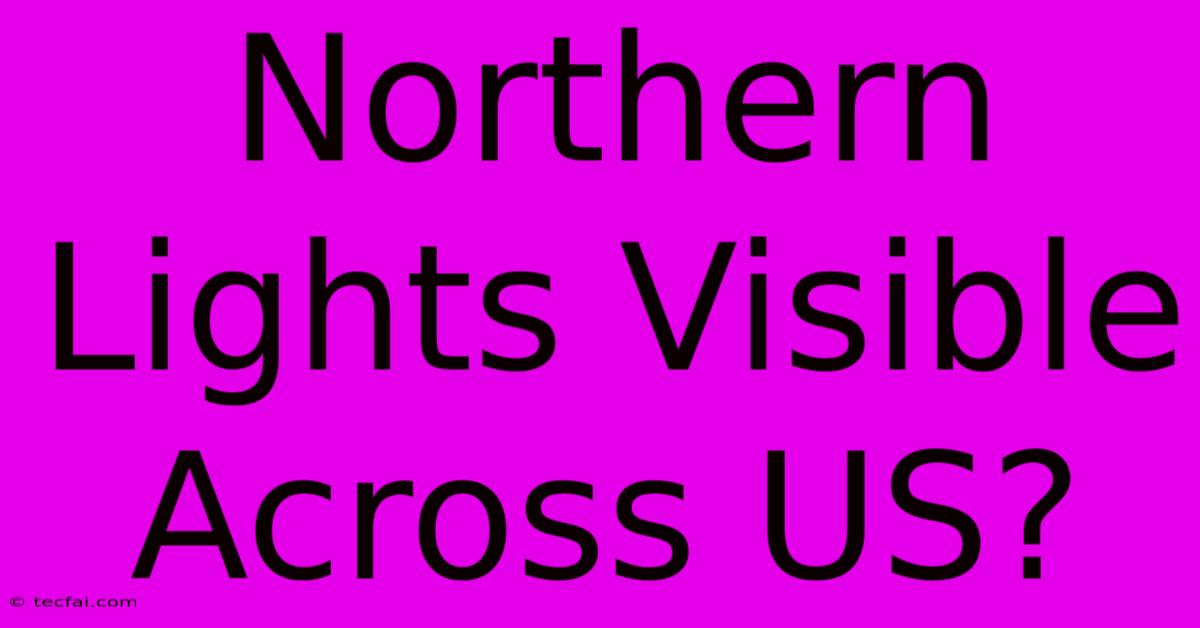Northern Lights Visible Across US?

Discover more detailed and exciting information on our website. Click the link below to start your adventure: Visit Best Website tecfai.com. Don't miss out!
Table of Contents
Northern Lights Visible Across US? A Guide to Aurora Borealis Sightings in the Lower 48
The mesmerizing dance of the aurora borealis, also known as the Northern Lights, typically conjures images of remote Alaskan landscapes or the icy plains of Canada. But the question on many minds, especially during periods of heightened solar activity, is: Can you see the Northern Lights in the lower 48 states of the US? The answer, surprisingly, is yes—though it's not a guaranteed spectacle.
This article will explore the factors influencing aurora visibility in the US, helping you understand when and where to potentially witness this breathtaking natural phenomenon.
Understanding the Aurora Borealis
Before we dive into US sightings, let's briefly cover the science behind the Northern Lights. Auroras are created when charged particles from the sun collide with atoms in the Earth's atmosphere. These collisions release energy in the form of light, creating the vibrant displays of green, red, purple, and blue hues we admire. The closer you are to the Earth's magnetic poles, the greater your chances of witnessing this celestial show.
Why are Northern Lights Sometimes Visible in the Lower 48?
While the aurora is strongest near the Arctic Circle, powerful solar storms can send charged particles further south, resulting in aurora sightings at much lower latitudes. This is why, during periods of intense geomagnetic activity, the Northern Lights might be visible in states like:
- North Dakota
- Minnesota
- Montana
- Michigan
- Maine
- Washington
- Oregon
- Idaho
Even further south, a faint aurora might occasionally be visible under extremely favorable conditions.
Factors Affecting Aurora Visibility in the Lower 48
Several factors contribute to whether you'll see the aurora in the US:
-
Solar Activity: The intensity of the solar storm is paramount. Stronger storms mean a greater chance of aurora visibility at lower latitudes. You can monitor solar activity through space weather prediction centers. Look for alerts indicating high KP indices (a measure of geomagnetic activity).
-
Light Pollution: This is a critical factor. Cities with bright lights will obscure even the strongest auroras. To maximize your chances, find a location far from urban areas with minimal light pollution. Dark sky parks are ideal.
-
Time of Year: Winter months (October to March) offer longer nights, providing more opportunities to witness the aurora. The clearest skies are usually found during new moon phases.
-
Weather Conditions: Cloudy skies will completely block your view. Check the weather forecast for clear skies in your chosen viewing location.
Tips for Increasing Your Chances of Seeing the Northern Lights in the US
- Check the Aurora Forecasts: Several websites and apps provide real-time aurora forecasts, predicting the likelihood and intensity of auroral activity.
- Find a Dark Location: Get away from city lights. The further away, the better.
- Be Patient: Aurora displays can be fleeting and unpredictable. Be prepared to spend time observing the night sky.
- Use a Reliable Light Source: Avoid using bright white lights which interfere with your night vision. Instead, opt for a red light source like a headlamp with a red light filter.
- Bring Warm Clothes: You'll be spending a significant time outside in potentially cold temperatures.
Conclusion
While not a regular occurrence, witnessing the aurora borealis in the lower 48 US states is a possibility. By understanding the factors influencing aurora visibility and using the tips outlined above, you can significantly increase your chances of catching this unforgettable celestial spectacle. Remember to plan ahead, check the forecasts, and be patient—the reward of witnessing this incredible natural wonder is well worth the effort.

Thank you for visiting our website wich cover about Northern Lights Visible Across US?. We hope the information provided has been useful to you. Feel free to contact us if you have any questions or need further assistance. See you next time and dont miss to bookmark.
Featured Posts
-
Revealed Lana Del Reys Uk And Ireland Ticket Costs
Nov 28, 2024
-
Snells Deal Impact On Flahertys Future
Nov 28, 2024
-
Deconstructing The Blake Snell Deal
Nov 28, 2024
-
Weeks Missing B C Hiker Rescued
Nov 28, 2024
-
Celtic Champions League Prize Money
Nov 28, 2024
